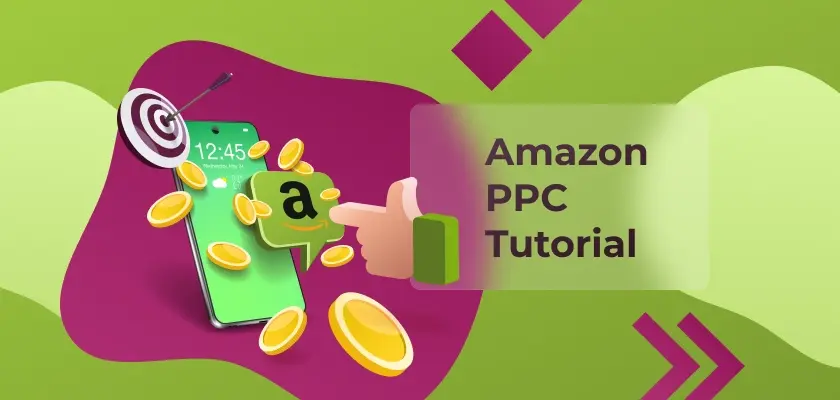Table of Contents
- 1 What Is Amazon PPC?
- 2 Amazon PPC Management
- 3 Types of Amazon PPC Advertising
- 4 Amazon PPC Guide: How to Set up an Effective Campaign
- 5 How Much Should You Allocate to Your PPC Campaigns on Amazon
- 6 Calculating your Ideal Advertising Cost of Sale
- 7 Optimize Your CPC Bids
- 8 Guidelines for CPC Optimization:
- 9 Conclusion
 It’s no secret that PPC advertising can be a pretty effective tool to help you attain more sales. But for better performance, it’s crucial to complement your Amazon PPC strategy with a higher conversion rate of your customers into reviewers. It is where SageMailer comes in, a highly efficient and reliable Amazon PPC tool. SageMailer only takes a few minutes to set up, and you can capitalize on all PPC sales and have an opportunity to turn your buyers into reviewers.
It’s no secret that PPC advertising can be a pretty effective tool to help you attain more sales. But for better performance, it’s crucial to complement your Amazon PPC strategy with a higher conversion rate of your customers into reviewers. It is where SageMailer comes in, a highly efficient and reliable Amazon PPC tool. SageMailer only takes a few minutes to set up, and you can capitalize on all PPC sales and have an opportunity to turn your buyers into reviewers.
If you ask most successful Amazon sellers what constitutes their top 3 success tools, Amazon PPC is one of them.
What Is Amazon PPC?
Through Amazon pay-per-click advertising, it’s possible to advertise to many people who regularly use the marketplace to purchase as opposed to individuals who are just browsing online. The best part is that Amazon enables you to target those just looking to buy the kind of product you are selling! There is just no better way to spend your ad dollars. It explains why nearly all successful sellers rely on PPC marketing.
Amazon PPC Management
Adopting the right PPC management is crucial for those who want to start on Amazon. While you can’t deny the effectiveness of organic search traffic, the issue is that it often takes months for it to gain results. Therefore, if you want to rank your service or product and get ahead of your competition, you need to invest in PPC first. Once you notice an increase in sales and reviews and start climbing up the listings ladder, you will certainly be able to cut back on your ad spend and take advantage of the organic traffic.
The good news is that it’s pretty simple to set up an Amazon ad campaign by simply following easy instructions. However, after you successfully set up your first campaign, you will want to get as much insight as possible to ensure that the money you spend on your PPC campaign is a worthwhile investment. So, read below to see how you can set up your first Amazon PPC marketing campaign and start advertising on Amazon.
Types of Amazon PPC Advertising
There are three main Amazon ad types available: Sponsored Products, Sponsored Brands, and Sponsored Display Ads (former Product Display Ads, PDAs).
Sponsored Products are ASIN- and keyword-targeted advertisements similar to Google Adwords that help you promote specific products within the platform’s search results or on product detail pages. It is the most popular type of ad on the marketplace.
Sponsored products ads always perform great when it comes to click-through rates and sales conversions. This type is highly beneficial because the ads intermix with the organic results and impersonate them.
Usually, they are displayed below Amazon’s organic search results, somewhere on the right side of the search results or on your product detail page. Such ads work the best only when you have done your homework on keyword research.
For starting the Amazon Sponsored Products campaign, choose a product, select the keyword term, and allocate your budget. After this, Amazon will target your sponsored ads automatically to a suitable audience.
Research proves that businesses have experienced better sales with Amazon Sponsored Product ads management than with Google Ads. Moreover, they are significantly cheaper than Google’s CPCs.

Sponsored Brands – ads for building the brand that allow companies to promote a brand logo, custom headline, and up to 3 products in their advertisement in the top spot above Amazon search results. It also helps send users to your Amazon Stores page or a custom landing page on the platform. In addition, you can use the feature of video ads linking to product detail pages.
Sponsored Brands ads also follow a PPC advertising model. If shoppers click on your ad, the Amazon marketplace charges your business for the ad. You don’t pay the platform to display it, but when a user clicks on it, you pay for it.
Keywords are another component of Sponsored Brands. Your marketing team targets and bids on keywords relevant to your item in your Sponsored Brands campaign. For instance, if you sell camel soap, you may target the keyword “camel soap” but not the keyword “goat soap” in your ad campaign.
This kind of Amazon ad also includes automatic or manual bidding. Amazon optimizes your bids automatically with automatic campaign bidding, but only lowering them never increases your requests. Your team or dedicated advertising agency should oversee your keyword bids if you select manual bidding.

Sponsored Display ads – advertisements that send buyers to Amazon product detail pages. They deliver relevant ads on Amazon and external websites to shoppers or remarket specific products on Amazon.
Each advertising type has its screen placement section, budget and differs significantly in the click-through rate and conversion rate influences. In addition, the platform allows merchants to match every transaction with an intended target audience for a Display Ad.
As an Amazon seller, you get to target the product detail page, related interests, related categories, and complimentary product listings.
Whenever you opt for advertising your product, it is vital to comprehend three things:
- Type of product
- Objective
- Target audience

Amazon PPC Guide: How to Set up an Effective Campaign
Step 1. Begin by signing in to your Seller Central Account. After that, click Advertising from the top menu, and select Campaign Manager.

Step 2. While on the Campaign Manager page, you will be prompted to “Setup your campaign budget and duration”. While the majority of this is generally basic, we still need to make some points about this section. Here are the steps you need to follow:
- When naming your campaign, remember that you can form multiple ad groups in one campaign. This is why it’s important to choose a broad campaign name. For instance, if you want to run ads that cover the summer season, it’s okay to name it Summer 2018. However, you can also create several groups within that campaign with different keywords. After that, you will be prompted to name groups on the following page. You can name them “Summer 2018 A” and “Summer 2018 B”. You can also create other names based on your own preference.
- When you set a daily budget, remember that the daily budget can add up pretty quickly. Therefore, a daily budget of $50 translates to $1500 in one month. It’s advisable to make up your mind regarding your preferred monthly budget then decide how much you want to spend daily.
- When determining your campaign’s start and end dates, it’s highly recommended that you choose an end date instead of leaving it open. You can easily spend your ad dollars without knowing it, especially if you are busy working on another campaign. A length of a month is recommended as this allows you to get enough data and stats from your search term report.
- If you select Automatic Targeting, the keywords will be generated automatically by Amazon based on the product you’re advertising. This is advantageous if you are looking for information from customer searches. Meanwhile, Manual Targeting lets you choose specific keywords that will be used for your campaign. For the example above, we will go with Manual Targeting.
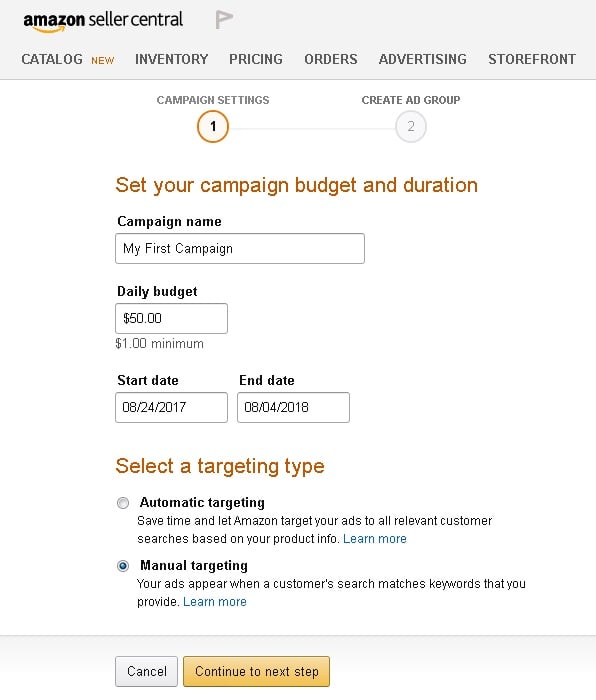
Click the “Continue to the next step” option once you have entered the necessary details and made the appropriate selection.
Step 3. Once you’re on the next page, you will be prompted to “Name this group of ads”. Remember that it’s possible to add multiple advertisement groups to one campaign. It’s therefore important to select an appropriate name that distinguishes it from the rest.
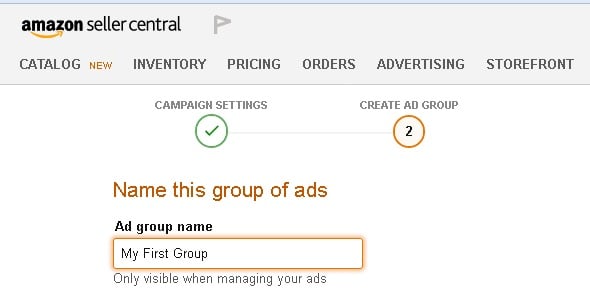
Step 4. After that, choose the product that you want to advertise. You are only allowed to choose a single product for each sponsored product ads campaign.
Step 5. You should decide on your budget for each keyword. Remember that by setting your daily budget and keyword bid, you are basically determining the number of clicks you can receive per day. For instance, if your daily budget is $50 and the keyword bid is $1, you can only receive 50 clicks on your ad every single day. Therefore, make sure to set these amounts properly for maximum effectiveness.

Step 6. The next step is to select your keywords. This is arguably the most complicated and probably the most crucial segment of your campaign. At this stage, it’s no use worrying yourself about being a keywords expert. You will be mainly learning from experimenting at first.
You will realize that Amazon provides some keyword suggestions. If you don’t have a list already, you can just choose any of their suggestions. Suggested keywords will show up in the box below as you select their keyword suggestions.
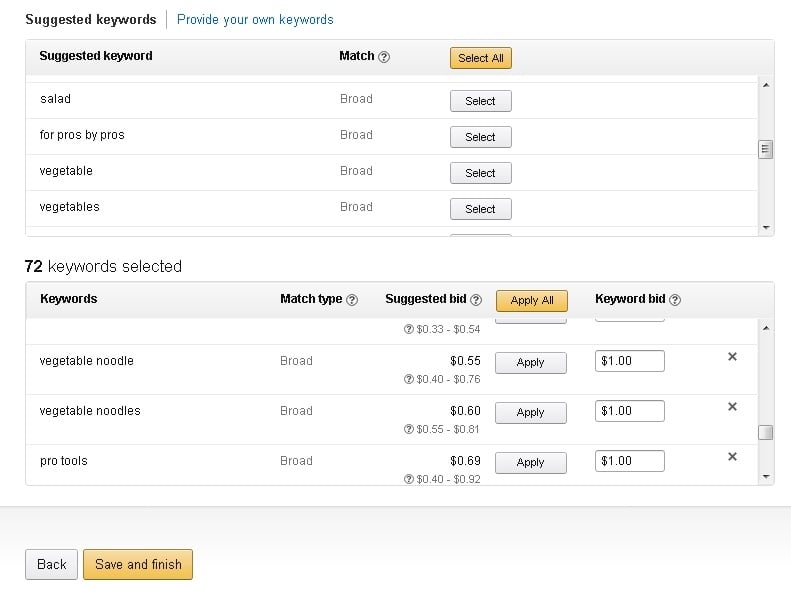
However, if you have your own list that you want to use, simply click “Provide your own keywords” instead. After that, type one keyword per line. You will also want to decide whether you want a Phrase Match, Exact Match, or Broad basis.
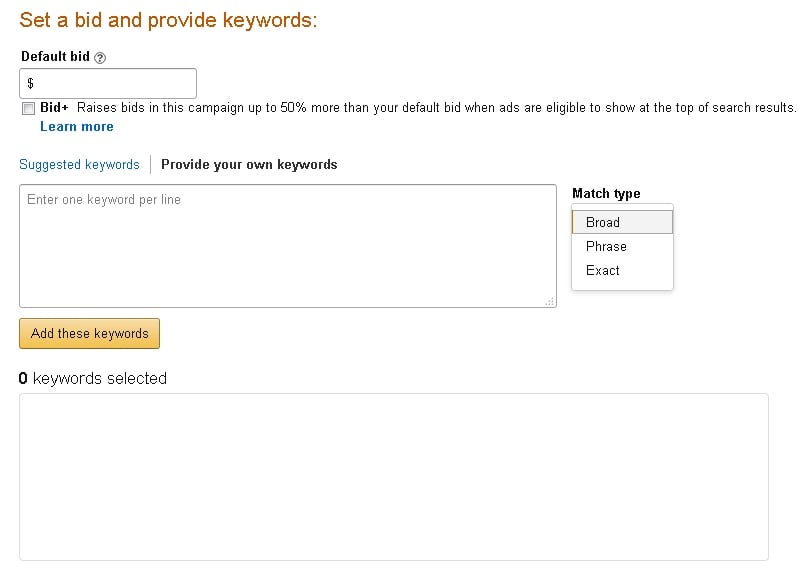
Step 7. After you are done entering your preferred keywords, simply click “Save and Finish” located at the bottom part of your screen.
Step 8. After providing the necessary details, you will be redirected to the Campaign Manager page. You should expect a “Success” message to greet you. New campaigns will usually take roughly an hour before your ads will start to appear in search results.
How Much Should You Allocate to Your PPC Campaigns on Amazon
The amount you need to spend on your ad campaigns will depend on a number of factors. First and foremost, you need to consider how much you want to spend on your PPC efforts. Second, you need to figure out how much your current budget is. Lastly, you need to keep track of your conversion rate, particularly how well your paid traffic performs in converting visitors into sales.
There’s actually a lot more factors you should consider. What you need to remember is that as long as your running ads are converting into sales, it’s only ideal to keep your ads running. This means that you need to continuously spend money just as long as you gain a healthy ROI. I think it’s better to consider your advertising expenses on a per unit basis compared to assessing your expenses based on your budget.
A useful metric that can help you assess the amount you need to spend in order to get a sale is the ACoS (Advertising Cost of Sales). Hence, it’s only ideal to determine your preferred Advertising Cost of Sale first before you begin running your automatic or manual campaigns.
Calculating your Ideal Advertising Cost of Sale
Amazon refers to the cost per conversion as the “Advertising Cost of Sale”. In order to calculate your ideal ACoS, here are some factors you need to take into account:
- Price of your products
- Cost of your sold products (the cost of one unit you pay your supplier)
- Miscellaneous fees such as the cost of packaging, shipping, etc.
- FBA fees
Now let’s use some examples:
- Price of your products: $40
- Cost of your sold products: $10
- Miscellaneous: $2
- FBA fees: $15
Subtracting all three variables from your product’s selling price will give you $13 in profit for every single unit: (40-10-2-15 = 13). This means that you can spend as much as $13 and still rake in some profits. In order to calculate your Advertising Cost of Sale, you simply divide your net income from the price of your products. For example, $13/$40 = .32. This means that you have a 32% ACoS threshold. In other words, you can make money on any keyword with a Cost of Sale of 32% or less.
Optimize Your CPC Bids
Now that you’ve successfully set up your campaign, the next step is to optimize your CPC (cost per click) bids. This will help you monitor how much you spend on your Amazon ads and avoid bidding on certain keywords that won’t convert.
You need to keep in mind that testing your bids is a vital aspect of CPC and PPC optimizations. However, you can only optimize your bids once you have gathered enough data to decide whether you have to increase/decrease your keyword bids.
Since you already know how to calculate your ideal ACoS, it is now easier to measure the performance of your PPC ads against your goal profit margin by comparing your current ACoS to your ideal ACoS.
Guidelines for CPC Optimization:
- If your current ACoS is higher than your ideal ACoS, you’re basically spending too much. It’s ideal to lower your bid to check if you can lower your expenses without having a negative impact on your sales.
- If your current ACoS is lower than your ideal ACoS, you basically have more money to spend. It’s best if you increase your bid and check if your ad reach can significantly improve.
- If your keywords don’t receive any impressions, you need to check the product category and make sure that what you’ve entered is correct and that your keyword is included in your list. If everything’s correct, you need to increase your bid and check if placing a higher bid will make the keyword “active”.
- If you have keywords that aren’t making any sales for a long period of time, and remain unprofitable after lowering your bid, it’s ideal to remove them from your campaign and place them in your negative keywords list.

Conclusion
Once you’ve followed the steps mentioned, you now have a successfully set up PPC Amazon FBA advertising campaign that can give your service/product the exposure it requires.
It’s very important to be patient. While you want to track the progress of the search terms you selected, note that it takes a while to gather and collate data detailing the keywords you need to keep and which to remove.
Setting up your pay-per-click campaign is just the start of your journey towards a successful Amazon marketing venture. Don’t be discouraged if your first campaign does not meet your expectations. You’ll get more efficient in increasing your sales and lowering your ad spending as you learn the ropes on how to settle your budget and choose successful keywords.
At this point, your PPC advertising strategy is pretty set up. However, this is the right time to begin using SageMailer to boost product sales and turn your buyers into even more Amazon product reviews. Amassing many product reviews leads to better conversion rates and increased sales. It’s a wonderful cycle. Click here to start your SageMailer free trial.
